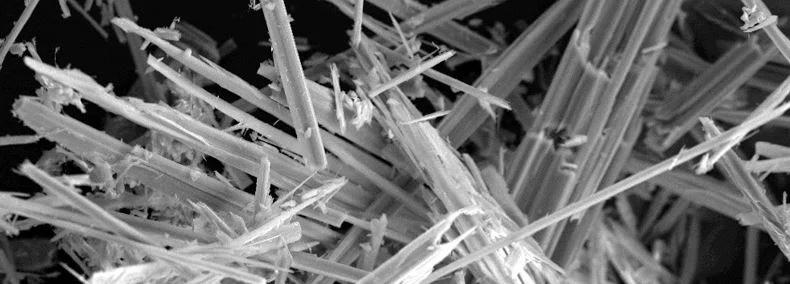What is Asbestos?
Asbestos is used generically to describe six minerals that share similar physical characteristics, specifically being natural strong mineral fibres, all with a high melting temperature but which are chemically different.
Up until the 1980's three of the six have been extensively used in construction, these were:
Crocidolite (blue asbestos);
Amosite, (brown asbestos);
Chrysotile, (white asbestos).
Amosite and Crocidolite are the ones most closely associated with health issues and were typically used in pipe lagging and fireproof coatings.
Chrysotile, making up more than 95 percent of the asbestos used around the world, is found in asbestos-cement sheeting and corrugated roofing, floor and ceiling tiles and as reinforcing fibres in textured coatings such as Artex.
As stated above Asbestos was used because of its fireproof fibrous nature. Unfortunately, the latter is also what makes it hazardous when inhaled, causing irritation and potential for cancerous growths.
How dangerous is asbestos?
Crocidolite and amosite are high risk and if found should only be dealt with by licensed professionals.
There is a debate over just how dangerous Chrysotile (white asbestos) might be. Some experts claim it is chemically identical to talcum powder, and that it has been unfairly smeared. However, such experts have also been accused of being industry lobbyists by others with an opposing view.
What we have found worries people, from our experience in dealing with projects in older homes, is how to identify and deal with asbestos and also, the cost of having it removed.
Could there be asbestos in my house?
Any home constructed before the 1980s has the potential to have some white asbestos materials. Artex was still manufactured up until the mid-1980s. Asbestos-cement roofing sheets, rainwater pipes, gas flues, and cold water cisterns were also being used up until then.
Moreover, asbestos-cement panels used in water tanks were made mostly of asbestos-cement; the asbestos fibres being used to reinforce this brittle material. A standard asbestos-cement roofing sheet will be around 10% asbestos and 90% cement. However, as the asbestos is bound into a solid by the cement, and as long as it is not damaged, there is little chance of fibres being released into the atmosphere.
The infographic below illustrates where asbestos might typically be found in the home:
There is no legal obligation for asbestos-cement products to be removed. The Health and Safety Executive’s (HSE) advise is that if in good condition, it is more often than not safer to leave it undisturbed and in situ, rather than risk releasing fibres into the air by any action to remove it.
How to deal with asbestos
In the first instance, there are free downloadable sheets on asbestos removal on the HSE website together with their leaflet “A comprehensive guide to managing asbestos in premises” plus lots of other useful information.
On asbestos-cement roofing, the HSE’s advice is to leave in situ, either sealing it or covering it over.
Similarly, with textured coatings such as Artex, they can be left in situ and skimmed over with ordinary multi-finish plaster, or a coating called Artex Ceiling Finish. Alternatively, depending on the construction behind, they can be boarded over with plasterboard.
However, ceiling or wall should then be labelled, to warn what lurks beneath. Asbestos-cement or Artex should never be drilled, scraped or dry-sanded, which risks freeing fibres into the atmosphere.
Artex can be safely removed using a wet method using a wallpaper steam stripper or a special gel. As long as the Artex remains damp, the fibres will not become airborne. Precautions still need to be taken, including sealing doors and windows with polyethene sheets, disposable clothing and the use of a respirator. The scrapings should be then bagged while still damp, labelled ‘asbestos’, and taken to a local authority’s licensed local authority disposal site which exist in both Cambridgeshire and Hertfordshire.
For small quantities of white asbestos-cement sheeting, such as a garden shed or lean-to roof, it can be bagged for disposal at the same dumps. For information on the Cambridgeshire, facilities see here and for Hertfordshire here.
Blue and brown asbestos will need to be dealt with by specialist licensed removal contractors who will be obliged to notify the HSE about the removal, even when it is for asbestos-cement which can result in high costs.
PRE-CONSTRUCTION "Asbestos - Refurbishment and demolition surveys"
To comply with the regulations under CDM 2015, see our separate blog "How do the Construction Management Regulations 2015 (CDM 2015) apply to domestic clients?" In identifying any risks in the pre-construction phases on any residential project, Harvey Norman would always require homeowners to have a Refurbishment and Demolition Survey undertaken. Again the HSE website is a good starting point have produced a booklet on asbestos surveys Asbestos: The survey guide as well as the main bulk of the PDF, please see page 48 Appendix 1.
We will be able to recommend a surveyor at the appropriate stage of the project

